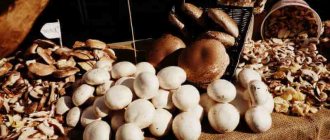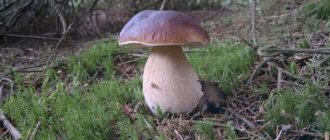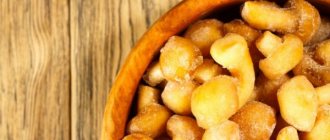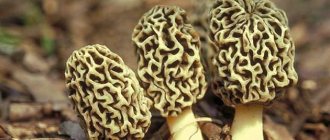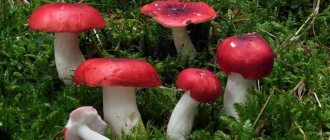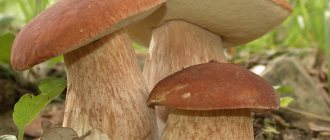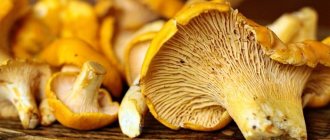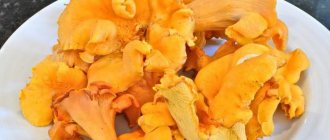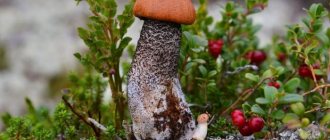Characteristics of single-barrel mushrooms
Despite the fact that single-barrel fruits have distinct characteristic features, they can be confused with inedible and even poisonous fruits, so you should be extremely careful when collecting them.
Appearance and photo
The fruit has a wide (from 4 to 30 cm) flat-convex cap with a curled edge. Old individuals can be distinguished by the funnel-shaped shape and smooth skin of the cap. Due to the shape of the cap, inexperienced mushroom pickers may confuse a single barrel with a chanterelle. The color changes from gray (or white) to yellow during the life of the fetus.
The leg is smaller than the cap, has a shape narrowed towards the base and is white or brown in color. The age of the fetus can also be assessed by the very cobwebby, cotton wool-like interior of the stem. Because it is too small, it is often not visible and may give the impression that the mushroom is growing without it at all.
Morphology
The single barrel has rare but fairly wide plates. Its flesh is white and quite dense. Old fruits lose the elasticity of the pulp and it becomes loose. The fruits have a pleasant, faint mushroom smell. The single-barrel mushroom is often called the most delicious mushroom from the Oyster mushroom family. The spores need grass to develop, which explains where the fungi spread.
Place of distribution in Crimea
Mushroom pickers advise going for a rich harvest to the valleys near Mount Demerdzhi, the Bakhchisarai forests, and the steppes near the Donuzlav and Sasyk estuaries. In addition to the Crimean region, single barrels can be found in the Lower Volga region.
Single-barrel oyster mushrooms differ from other varieties of the oyster mushroom family in their rather specific place of growth - they love the grassy cover of the steppe. While all other mushrooms usually grow under trees, single-barrel mushrooms can be found in open, damp areas. During periods of severe drought, you don’t have to look for them, because, despite their steppe habitat, they really love water.
Eating
Single barrels can be eaten and even more so - they are quite valuable for cooking. Mushroom pickers believe that these fruits are the most delicious among all members of the family and therefore are very popular. In addition, this variety contains a large amount of useful substances.
Can be used for drying, pickling, and preparing a variety of dishes. Please note that old mushrooms can only have caps. The legs become rougher with age, sometimes you even have to clean the joints between the knives and the caps.
Collection rules and conditions
Single barrels bear fruit almost all year round, from April until November. In especially warm years, fruits can grow even in early March, so when going into the forest you can almost always find them.
Difference from false, inedible mushrooms
Most often in collection areas you can find false mushrooms, pale toadstools and fly agaric mushrooms. Mushroom pickers advise not to put the entire harvest in one basket and not to rush to collect everything you find in the clearing, because inedible mushrooms grow apart from others.
You can distinguish an edible fruit by the way it grows: unlike many other edible and poisonous mushrooms, the one-barrel mushroom grows in groups and quite often the stems of the fruit are either as close to each other as possible, or even grow together and it seems that the fruit has several caps at once. This is the surest sign of this delicious fruit.
Mushrooms in Crimea 2021. Mushroom season in Crimea 2021: Top 5 most productive places
The mushroom season in Crimea lasts from May to November. But autumn is traditionally the most popular time of year for “silent hunting”.
Komsomolskaya Pravda talked to avid mushroom pickers and prepared a list of the best places to collect “forest gifts” and compiled the TOP most popular ones.
MUSHROOMS 6 MONTHS A YEAR
The peninsula is a real paradise for fans of saffron milk caps and russula. They can be collected in Crimea almost all year round, and the mushroom season in Crimea 2021 is no exception: at the end of May, if the rains have passed and warm nights have arrived, russula and chanterelles appear. And off we go. In summer and autumn, saffron milk caps, boletus, honey mushrooms, puffballs, porcini mushrooms, boletus mushrooms, russula, chanterelles, champignons, and mountain mushrooms grow in the forests and steppes. You can also find deer horns, which are especially popular among connoisseurs.
“Deer horns taste good, boil down a little and look great in a jar when storing for future use - they look like corals,” Vladislav Pluzhnikov, an avid mushroom picker from Sevastopol, told KP-Crimea.
With the onset of calendar winter, the “silent hunt” on the Crimean peninsula does not stop: when the main “players” leave the stage, what remains is a row. The little mice, so lovingly nicknamed this inconspicuous-looking mushroom, but not devoid of gastronomic delicacy. You can find it in the forest in December and January.
IT'S BETTER TO GO FOR HOUSEKEEPS ON WEEKDAYS
x HTML code
“This fall, the mushroom season in Crimea 2021 is not very productive,” says Vladislav Pluzhnikov, an avid mushroom picker from Sevastopol, to KP-Crimea. “There aren’t enough mushrooms, but there are a lot of people who want to collect them.” On weekends they mow everything down! Therefore, it is better to go to the forest on weekdays.
It is necessary to take into account that in order to obtain “forest trophies” you will have to spend gasoline and time. Chanterelles and saffron milk caps can hardly be found within walking distance.
— The surroundings of villages and towns are polluted, there is garbage everywhere. And I noticed that if in childhood it was possible to find the same boletus in the nearest forest, now the mushroom is moving away from civilization,” notes Pluzhnikov,
HOW TO STAY ALIVE FOR A MUSHROOM PICKER
All fans of outdoor recreation, going for a walk through forests and mountains, risk losing their bearings and getting lost. First you were looking for mushrooms, and then they start looking for you.
And if you have found your way home and are ready to fry, steam and salt your prey, be prepared for another danger - poisoning.
How not to get poisoned?!
“Before frying or pickling, I clean the collected mushrooms of debris, fill them with cold water, bring to a boil and cook for 7-10 minutes,” mushroom picker Pluzhnikov shares his secrets. “Then I put them in a colander, rinse them, fill them with water and put them back on the fire. And so three times!
An exception is made only for honey mushrooms and baby mice - they can be boiled twice.
— Don’t believe anyone that you can eat russula raw or immediately fry it in a frying pan. This could have been done 20 years ago, but now the ecology is changing, and mushrooms are changing their properties. And never pick mushrooms you don’t know. And it’s also not worth shopping at the market - maybe these honey mushrooms grew near the road.
WHERE TO FIND MUSHROOMS IN CRIMEA
There are quite a few places on the peninsula where you can go for edible trophies. A good harvest, if the weather is appropriate, grows starting from the western foothills of Sevastopol, and right up to the Old Crimean forests, which is towards Feodosia.
The most productive mushroom places: Baydarskaya Valley, Boar Pass, mountains along the Yalta highway, including Ai-Petrinskaya Yayla, Belogorsk forests (for example, Zelenogorskoye and Alekseevka).
You can also wander productively with a basket near Simferopol: in the vicinity of Kolchugino, Strogonovka and Mramorny.
TOP 6 EDIBLE MUSHROOMS OF THE CRIMEA
1. Saffron milk caps can be found under evergreen spruce and pine trees.
2. Chanterelles grow in deciduous forests.
3. Butterfly - coniferous forest, clearings.
4. Deer Antlers - Moist, dark places in deciduous or pine forests.
5. Honey mushrooms love to climb deep into the deciduous forest.
6. Porcini mushroom (boletus) is found in mixed forests.
MUSHROOM SEASON IN CRIMEA 2021: WHEN AND WHAT MUSHROOMS GROW
Summer mushrooms - russula, chanterelle, podgrudok, volnushka, poddubnik. Saffron milk caps and deer antlers appear at the end of summer.
Autumn mushrooms - autumn mushrooms, honey fungus and boletus. The little mice (row) gain strength at the end of November.
Useful properties and restrictions on use
Single barrels are valuable not only for their taste, but also for their high content of nutrients. In terms of the amount of vitamins and amino acids, representatives of this variety are close to meat and dairy products. The only vegetables that contain more protein than single-sided vegetables are legumes.
Eating fruits can also help cope with the following diseases and conditions:
- decreased immunity;
- atherosclerosis;
- high cholesterol levels.
Single barrels contain a huge amount of vitamins (especially group B), antioxidants, and beneficial acids. Their effectiveness in the treatment of anemia has been proven, and can be used to influence the symptoms of liver, kidney, and eye diseases.
Read also: Signs of estrus in ferrets
The mushroom has a unique tonic. Some athletes use single barrels to get a dose of energy before competitions, as a natural alternative to doping drugs. Like other mushrooms, single-barrel mushrooms are not included in the diet of children, pregnant and lactating women, and patients with gastrointestinal pathologies.
Where and when to look
The Crimean climate is very diverse and unpredictable, so the beginning of the mushroom season differs in different parts of the peninsula. While in one part of Crimea there are no traces of mushrooms yet, in another part of Crimea the season is in full swing.
Read also: A ripe apple comes off a branch of an apple tree and is attracted
It was also noticed that fruiting bodies grow there not only in forests, but also in clearings and roadsides. However, the talker, beloved by many mushroom pickers, still prefers traditional places - coniferous and deciduous forests. It is there, under the trees, that they grow. These mushrooms can be collected from early summer until mid-autumn.
Recipes and cooking features
The most common and easiest way to cook single barrels is to marinate. To do this, you will need to rinse well and clean the fruits from soil, sand, and grass residues. After this, you should boil the water - the mushrooms should be added only after boiling. On average, they need to be cooked for no longer than 30-40 minutes, stirring occasionally and skimming off the foam. The marinade recipe for steppe mushrooms is very simple.
To prepare, you will need the following ingredients (per 1 liter of water):
- 3 teaspoons vinegar;
- 2 tablespoons each of crystalline sugar and salt;
- a pair of bay leaves;
- pepper and cloves to taste.
As soon as you see that the fruits have settled to the bottom of the pan, you can remove them from the heat and put them in jars, immediately pouring them with the pre-prepared marinade. Then roll up the cans and place them upside down, wrap them up.
Pickled oyster mushrooms
You can also prepare very tasty hot sandwiches, which are suitable for a gourmet breakfast, as an addition to soup, and as a snack on the holiday table. To prepare the dish, you need to take:
- slices of white bread or toast;
- a small amount of vegetable oil for frying.
- smoked bacon;
- onion;
- mushrooms (about 200 g);
- hard, melting cheese (100-150 g is enough);
- sour cream and spices (salt, pepper, etc.) to taste.
Answers to common questions
In the process of preparing single barrels, housewives often encounter difficulties. We have collected the most frequently asked questions and answers from experienced chefs:
Single barrels are common in the southern regions, most of them in Crimea. The species bears fruit for a very long time and the main criterion for yield is good humidity in the place where the species grows. A distinctive feature of the single-barrel variety is that they live in open areas, in the steppes, and not under the canopy of trees.
This variety is considered one of the most valuable not only because of its taste characteristics, but due to the large number of useful substances. Single barrels are used in the treatment of many diseases; they are eaten pickled, dried, or fried. They can be used to prepare many everyday and gourmet dishes.
Fungi are eukaryotic organisms that lack chlorophyll. They differ from lower plant and animal species anatomically, biologically and morphologically. The article presents edible and poisonous mushrooms of Crimea. We invite the reader to read their descriptions and look at photographs. There are a lot of mushrooms on this peninsula, and they grow in a variety of places: from the steppe to forests and plateaus.
Chanterelles
Another name is cockerels. The lands of the Simferopol region are rich in them. There are many of them near the village of Mramornoe. Mushroom pickers also go to the forests of Belogorsk, Kirov, and Bakhchisarai regions.
p, blockquote 19,0,0,0,0 –>
Chanterelles grow in numerous groups in sunny places, in clearings or next to clearings. They are also found in moss, among birches, pines, and spruces. Appear from the beginning of June. You can collect all summer until the first autumn frosts.
p, blockquote 20,0,0,0,0 –>
A distinctive feature of the structure: the mushroom does not have a pronounced transition from the stem to the cap. Uniform color: yellow (shades vary from light to dark, almost orange).
p, blockquote 21,0,0,0,0 –>
The hat has an irregular shape with wavy, unfolded edges that form a depression in the center. But its surface is absolutely smooth. The leg tapers downwards, the length is about 5 cm. The flesh is fleshy, dense, with a slightly sour taste. When pressed, it acquires a reddish tint. The smell is weak.
p, blockquote 22,0,0,0,0 –>
It must be distinguished from the false chanterelle, whose cap has no bends and resembles small funnels. In addition, their color is always orange, closer to red. The yellow hedgehog also looks like a chanterelle. This is an edible yellow mushroom. It has a fleshier cap and a thicker white stalk.
p, blockquote 23,1,0,0,0 –>
Chanterelles are very good for health. They help get rid of helminths, have a beneficial effect on liver cells (containing ergosterol in mushrooms), and are a source of vitamins. Increases the body's resistance to infections.
p, blockquote 24,0,0,0,0 –>
Read also: Marinated Crimean steppe mushrooms
Chanterelles are easy to transport; they do not break when carried. You can cook it in any form. True, when fried they somewhat lose their taste. Pairs well with other mushrooms, such as porcini and boletus.
p, blockquote 25,0,0,0,0 –>
Mushroom history of Crimea
The season usually begins after the onset of Indian summer, but in general, they can be collected all year round, at any time. Although there are a lot of mushrooms on the peninsula, they have never been considered the main food. Therefore, only amateurs collected them. This attitude continued into the 20th century. Afterwards, Mediterranean cuisine came into fashion, including various mushroom sauces. People have reconsidered their attitude towards food. Thus, Crimean mushrooms began to enjoy great success among the population of the peninsula.
Raincoats
Puffballs are mushrooms that cannot be poisoned. But when collecting them, you still need to check their flesh: in a real raincoat it is always white. Giant and pear-shaped raincoats are common in Crimea. The first has a fruit body that is round and white, but becomes yellowish over time. Can reach a height of 34 cm.
p, blockquote 43,0,0,0,0 –>
Also interesting to read: Poisonous mushrooms of Crimea
p, blockquote 44,0,0,0,0 –>
The fruiting body of the pear-shaped puffball is very similar in shape to a pear. The skin is rough with small tubercles. Raincoats grow in the foothills, choosing rotten wood for themselves.
p, blockquote 45,0,0,0,0 –>
Only young mushrooms are suitable for food. They are dried or fried. They also make a delicious mushroom soup. In terms of nutritional content they can be compared with white ones.
p, blockquote 46,0,0,0,0 –>
300
Crimean steppe mushrooms: single barrel
This is another interesting representative of the mushroom world, which is often called the crane. Loves to grow among grass in steppe areas. It's just hard to find a single barrel. Local residents (near Simferopol) are accustomed to calling it differently, each with its own associations. For example, you can often hear the word “ungulate”. This name was given to it because of its woody stem. Many people call it duck because of its growth characteristics. She stands as if “waddling”, like a tired bird. Sometimes you can stumble upon a whole “vegetable garden” of these mushrooms.
A single barrel is very similar to an oblique funnel, which has rolled edges of the cap. The blades are wide, white and sparse. But the main feature of this mushroom is that it grows precisely in the grass, on the prickly tartar or eryngium field. The season usually starts in May and ends in November. But there were cases when she was found in January. For food it is used freshly prepared; many people prefer to pickle it.
Since the steppe zone of the peninsula occupies more than half of the territory, mushrooms of this area include honey mushrooms, boletuses, boletus, boletus and saffron milk caps. These species are no different from their counterparts, except that they grow in grass and not under trees. The most popular steppe mushrooms of the Crimea are oyster mushrooms and single-barrel mushrooms. They belong to the same family. But they have their own characteristics. Although many people mistake them for one species. The single barrel grows in the bare steppe, which is completely devoid of trees. But oyster mushrooms live on decaying trunks.
Mushrooms in Crimea 2021. Top 5 productive villages where you can pick mushrooms in Crimea
Crimea is a peninsula of treasures. Nature, beaches, sights... But there is another tasty, aromatic, sometimes delicious treasure. Let's talk about where in Crimea you can pick mushrooms and when to go for them.
For the little mice in Kolchugino
The village is located near Simferopol. The distance between the settlement and the city is 27 km. Transport is rare, so it’s convenient to rent a car, load baskets in the trunk and go harvesting in comfort.
Mice are also called gray mice. These mushrooms are often small, but giants are not uncommon. They can be found from September to November in coniferous and mixed forests. Mice grow on sandy soils, near old pine trees and simply in fallen leaves and pine needles.
For chanterelles in Mramornoe
The village is located 21 km from Simferopol. This is the mountainous part of Crimea, the western foot of Chatyr-Dag. The most convenient way to get here is also by rented SUV.
Chanterelles are family mushrooms that grow in clusters in open meadows or in the shade of trees. They live in coniferous, mixed forests and birch forests. They can be seen by their wavy caps, which are fused with the legs into a single whole.
For saffron milk caps in Rybachye
If you travel by public transport, you will have to get from Simferopol to the second bus station “Kurortnaya”, and then change to a minibus to the village. You can get there from Alushta by car in an hour if you follow the coastline.
Saffron milk caps usually grow during Indian summer and until the end of October. You need to look for them in a shady place under a pine or spruce tree, in longitudinal grooves, holes, and ravines. These mushrooms are easy to recognize: they have large orange caps and long stems.
For boletus in Zelenogorskoye
Zelenogorskoe is located almost 40 km from Simferopol. You can cover this path in an hour and a few minutes. The village itself is large and has a lot of interesting things to do. For example, a workshop for the production of kumys.
If you like boletus, you can also go to Ai-Petri, where in bright places, around stones, on the edges and clearings you can find many brown caps. They love open areas. When to collect? Not worth it in early summer. In the hot season, insects feed on them. The time is coming closer to autumn.
For steppe oyster mushrooms in Grushevka
Grushevka is located near Sudak. It only takes about 40 minutes to get there. In addition to mushroom places, there are also the remains of two settlements from the Bronze Age and the Middle Ages.
The second name for steppe oyster mushroom is single-barrel. Local residents also give her other funny nicknames: ungulate, duck. An interesting mushroom that grows uniquely - on grass. The harvest can be from late spring to November in spiny tartar or field eryngium.
Are there other places where you can pick mushrooms in Crimea? Certainly. In the village of Nauchny around the observatory there are many suitable areas. Porcini mushrooms are hidden on the South Coast, milk mushrooms - in the Bakhchisarai region, oak mushrooms - in the mountains.
Poisonous Crimean mushrooms
There are approximately 45 species of these. Poisonous mushrooms of Crimea are divided into 5 groups according to their toxicity.
- 5th group: gray entoloma, tiger row, flat-capped champignon. Symptoms of mild poisoning begin between 30 minutes and 5 hours after consumption. The malaise lasts up to a week.
- 4th group: inky and shaggy dung beetles. Poisoning occurs when drinking alcohol at the same time. Therefore, you should not drink it for three days after the mushrooms have been eaten.
- 3rd group: talkers (pale, reddish, orange-red and waxy). All symptoms of poisoning begin 15 minutes after eating mushrooms. Sometimes they lead to the death of a person.
- 2nd group: red and panther fly agarics. Poisoning can often result in death.
- Group 1 - the most poisonous mushrooms, fatal to humans. These include: pale toadstool, spring white and green fly agarics and cherry-brown silverfish. Symptoms begin to appear almost immediately after consuming them.
Read also: Children's simple holiday table
Although all these mushrooms are poisonous, they can also be useful for humans. Some of them are used by pharmacists to prepare various medicines and are sometimes included in herbal teas for brewing. Of course, the dosage is the minimum.
How to avoid mushroom poisoning
The main causes of poisoning are caused by improper collection and storage. Mushrooms growing in Crimea also have false counterparts. They are difficult to distinguish from edible species. The market even has special expertise that is available to anyone to check their trophies.
To prevent poisoning, when purchasing mushrooms, you need to carefully examine them to see if they are poisonous. It is better to simply throw away the doubtful ones. Their age differences are also important. Old and wilted mushrooms are difficult to recognize as to whether they are edible or poisonous. If there is even the slightest doubt, it is better to simply refuse them.
Mushrooms must be processed and prepared on the day of collection. Otherwise, toxic substances may form in them. First, you need to boil them in water for ten minutes and only then fry and re-cook them. Some mushrooms in their raw form, if you simply lick your tongue, leave a bitter taste on it. These can be thrown away immediately - they are poisonous. Even if they look edible.
Where to pick mushrooms
Many people prefer the Crimean mountains, where the famous porcini mushroom is most often found. The Ai-Petri Yayla enjoys great success. There are also many of them on the flat tops of mountain ranges. And the forests near Mount Demerdzhi - in Luchistoye - are considered excellent places for “silent hunting”.
There are many good places near Sevastopol - where the forest stretches to Bakhchisarai. In the east of the peninsula, mushrooms are collected from Feodosia to Old Crimea. The steppe zone is also rich in them - near the Donuzlav and Sasyk estuaries. The largest number of mice can be found in the area of Kolchugino and the Crimean Observatory. Saffron milk caps are found near Rybachy, and chanterelles are collected in Mramorny. Butterflies are most often found in Stroganovka and the Zelenogorsk region.
Mountain white mushroom
It has many names: giant pigwort, huge leusopaxillus. But the most accurate thing is the giant talker (Trichlomocha family). Prefers the soil of deciduous and coniferous forests. Found from early summer to mid-autumn.
p, blockquote 5,0,0,0,0 –>
Mountain porcini mushrooms grow in groups. If one is found under a birch or pine tree, there is a high probability that there are several more nearby. It's easy to spot them. The caps are large and fleshy (up to 20 cm in diameter). They can be completely white, but they also come in a pleasant coffee-with-milk color. If the mushroom is completely white, it means it is young and fresh. The hat should be smooth on top and covered with plates with bridges on the bottom.
Mushroom ethics
Lovers of “silent hunting” have their own ethics. You cannot kick mushrooms even if they are of no interest. Someone else may need them. Ideally, collection occurs in baskets woven from twigs. This is due to the fact that plastic buckets and bags do not allow air to pass through, and the collected mushrooms may not make it home. They need to be cut off with a knife, close to the ground, so as not to damage the roots.
You cannot pull them out of the mycelium and tear the moss. This damages and destroys the roots. Under the bright sun, the mycelium dries out and dies. The most favorable time for collection is after a warm rain, especially if it happened at night. In order to preserve the mycelium, a rotten specimen that comes across the path is broken into small pieces and scattered around.
Autumn honey mushrooms
Real autumn honey mushrooms are collected everywhere from the end of August to the end of autumn. These mushrooms almost never grow alone. They usually parasitize whole families on trees and stumps. Prefer moist soil.
p, blockquote 26,0,0,0,0 –>
In young honey mushrooms, the cap is concave inward, with growth it opens and becomes flat (size from 2 to 15 cm). The legs are long - up to 10 cm. The color of the caps and legs is the same - honey, but they have flake-like scales of a dark color, which is why honey mushrooms look brownish and slightly fluffy. There is a filmy ring under the cap.
p, blockquote 27,0,0,0,0 –>
False poisonous honey mushrooms have a gray-yellow color. The cap is whitish at the edges and has no scales. The pulp is light yellow with a bitter taste and earthy smell. The spore powder is brown, while in the autumn honey mushroom it is white.
p, blockquote 28,0,0,0,0 –>
Honey mushrooms can be prepared in different ways. It is better to boil peeled honey mushrooms in salted water for about five minutes. Be sure to then place them in a colander and allow the water to drain. Before serving, they are crushed, poured with sour cream or sprinkled with green onions. For pickling, cook for 20 minutes, after rinsing and removing dirt. After cooking, place in a glass container, add bay leaf, pepper, onion and dill. It is good to place mushrooms and additives in layers, one on top of the other.
p, blockquote 29,0,0,0,0 –>
Answers to common questions
The white Crimean mushroom is a rather exotic species found in the Crimea. Despite the fact that the species belongs to the conditionally edible mushrooms, it is still widely popular among mushroom pickers, who quite often go to the mountains or villages just for it.
“At the same time, if all the preparatory steps are followed (thorough cleaning, washing and quick cooking), certainly edible mushrooms should not be pre-cooked before sauteing under any circumstances. This rule applies to porcini mushrooms, chanterelles, saffron milk caps, champignons, morels, umbrella mushrooms, cap mushrooms, russula and row mushrooms. Of course, prolonged heat treatment of mushrooms will not harm the human body. However, the nutritional value of “our forest beef” decreases, its taste deteriorates and its aroma weakens. In addition, some of the edible mushrooms become slimy after boiling.
«>
There is also no need to cook greenhouse champignons, oyster mushrooms and all fresh-frozen mushrooms that can be bought in stores before frying. Moreover: champignons grown on a sterile substrate can even be eaten raw, for example, added to a salad.”
Consider these my cockroaches. I think. that mushrooms need to be boiled. All. I feel calmer this way. But this does not affect the taste of mushrooms. I just ate a portion of fried whites. Boiled it before frying. Very tasty. Everyone always cooked mushrooms for me - my grandmothers, my father, my friends. And that’s what I do and will continue to do. And there’s nothing better than cheese to finish a glass of wine and nothing better than wine to finish a slice of cheese (c)
I believe that mushrooms must undergo long-term heat treatment. These are my cockroaches. This doesn’t affect the taste in any way, but for me it’s even tastier if it’s boiled with spices before it’s hot. And there’s nothing better than cheese to finish off a glass of wine and nothing better than wine to finish off a slice of cheese (c)
Clearly, I thought maybe there’s a scientific basis and I’m doing it wrong. And we’re straight out of the woods and into the frying pan. The eyes are afraid - the hands are doing it.
I tried mushrooms that were not cooked. They seemed harder and more rubbery to me. I prefer boiled ones. And I feel calmer this way. I don’t pretend that I’m doing the right thing. But in my family it’s customary And there’s nothing better than cheese to finish a glass of wine and nothing better than wine to finish a slice of cheese (c)
This is how it is in my family. In principle, I do not consider mushrooms to be a safe food. Therefore, I personally feel more comfortable eating myself and feeding my family with mushrooms that have undergone longer heat treatment. What does this have to do with your soup? And there is nothing better than cheese to finish a glass of wine and nothing better than wine to finish a slice of cheese (c)
Mushrooms are cooked, in my opinion, for certain purposes. In some mushrooms the bitterness is removed by cooking, in other mushrooms the dark broth is drained, and in each case this is done for a specific purpose. Why do you eat that? I don’t understand what you’re afraid of. In any case, the porcini mushroom, together with saffron milk cap, belongs to the highest category of mushrooms and does not require additional cooking. (And saffron milk caps can generally be eaten raw, I didn’t like it). Next, I will point out your inconsistency: you advised the author to cook the soup, but you did not advise draining the first broth , when frying, you pre-cook the mushrooms, although it is enough to boil them in their own juice in a frying pan for 10-20 minutes (depending on the type of mushrooms, the size of the cut and the quantity in the frying pan). Washed mushrooms always give juice in the pan, but draining or boiling it is a matter of taste. Longer heat treatment will not save you from mushroom poisoning; it makes the mushrooms less aromatic and healthy. And about the soup - I was bragging, kind of on topic.
Try it sometime! No, really. Get over your prejudices and fry yourself boletus. How delicious it is! They are. sweet. Now I fry moss mushrooms and white ones just like that. I also boiled it before.
